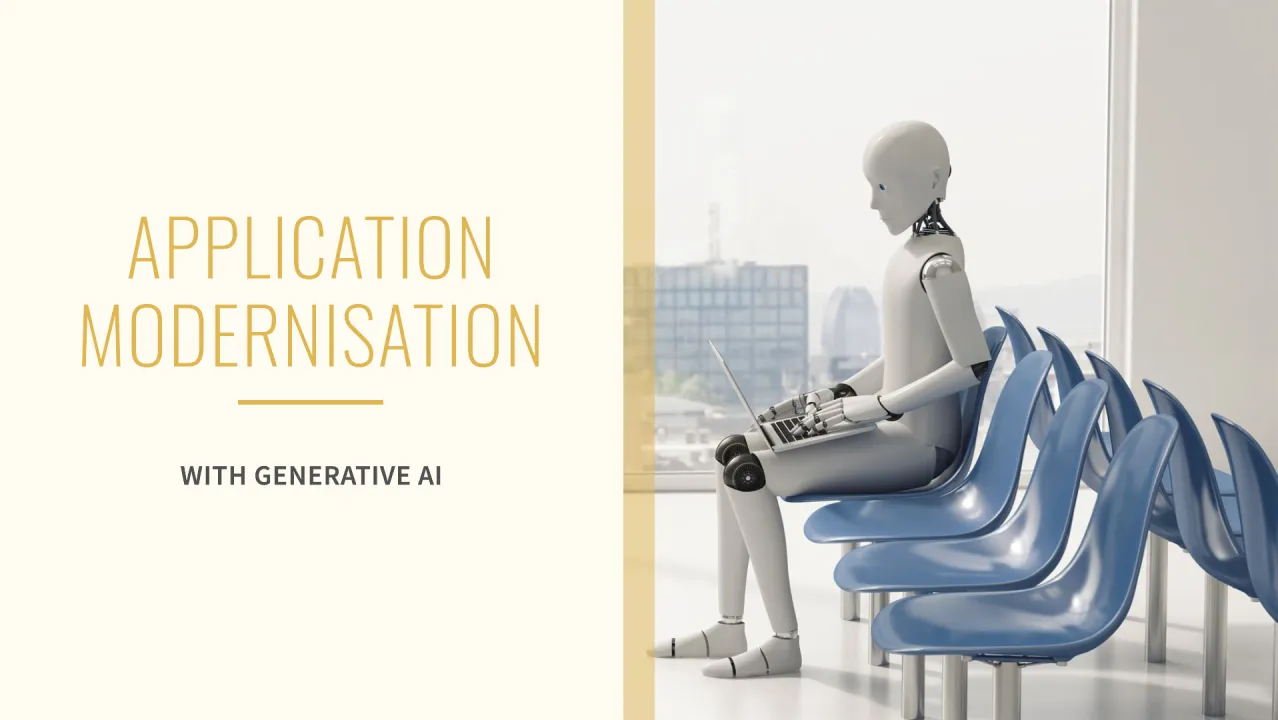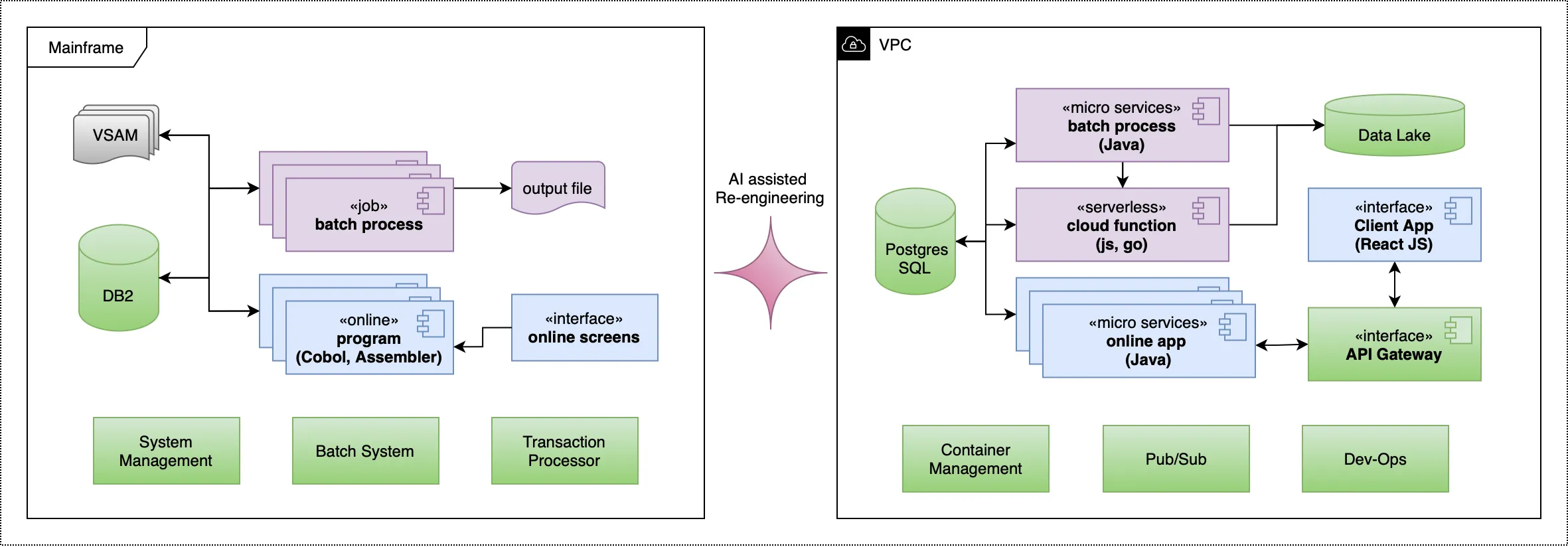
From Monolith to Microservices: Generative AI supercharges your legacy application modernisation
I’ve been in the trenches of application architecture for too long. Legacy systems are a constant headache—slow, brittle, and stifling progress. Generative AI is a force for change in modernisation. It won’t solve everything, but it accelerates and de-risks the process, giving experienced architects a robust new set of tools.
Table of Contents
Open Table of Contents
- Why Legacy Apps = Missed Opportunities
- AI: Your Modernisation Power Tool
- Beyond the Code: AI Gets the Big Picture
- Humans + AI = Dream Team 👍
- Metrics That Prove the ROI
- Further Considerations for Maximising Success
- Modernising a Core Banking Platform with Generative AI
- Target State Architecture: Designing Your Modernised Banking Platform
- Conclusion: The Future of Modernisation is Powered by Generative AI
Why Legacy Apps = Missed Opportunities
Modernisation with Generative AI unlocks agility (faster, safer updates), cuts long-term maintenance costs, and helps you close the competitive gap with modern tech stacks. Let’s break those down:
The Agility Struggle: Legacy code becomes like a house of cards. Every change has the potential to break something unexpected. With AI-powered analysis, you understand the code faster, make changes with more confidence, and get those new features out the door in less time.
The Cost Drain: Maintaining outdated systems is expensive. Developers spend time deciphering archaic code and outdated platforms, often incurring high licensing fees. AI-driven refactoring means cleaner, more efficient code, lower maintenance costs, and the ability to reinvest those savings into innovation.
Competitive Risk: While you’re stuck in the past, rivals use modern tools for rapid development and scaling. Generative AI levels the playing field, letting you migrate to the cloud smartly and adopt architectures that drive long-term business value.
AI: Your Modernisation Power Tool
Imagine having an expert consultant constantly at your side — one who knows the history of software and the latest architectural trends and can analyse your unique codebase in a flash. That’s the power of Generative AI for modernisation. Here’s how it becomes your indispensable sidekick:
AI Code Translator: Consider it the Rosetta Stone for legacy code. AI deciphers old languages (even those where the original devs are long gone), analyses the structure, and can even provide plain-language explanations of what different sections do. Months of manual work reduced to days!
Intelligent Refactoring: Converting code manually is slow and error-prone. AI handles the bulk of the conversion, giving you a solid starting point for the genuinely complex architectural decisions and letting you choose the most appropriate modern equivalents.
Design Guru: AI is constantly learning from current architectures. It will suggest microservices decompositions, optimised cloud deployment strategies, and ways to improve security within your new modernised stack — saving you massive research time.
The Pattern Spotter: Legacy systems often contain ‘reinvented wheels’ due to past tech limitations. AI can spot these patterns and suggest standard libraries or modern solutions, preventing you from wasting time rebuilding what already exists.
Intelligent Test Suite Generator: Writing tests for legacy code is a chore. AI helps by creating test cases based on code analysis, uncovering edge cases, and even generating synthetic data, giving you a headstart in ensuring the modernised system functions as intended.
Performance Predictor: Beyond just code conversion, AI can analyse legacy system behaviour and model how proposed architectural changes might impact performance. This helps you optimise early for scalability and avoid costly reworks later.
Beyond the Code: AI Gets the Big Picture
Legacy systems don’t just exist in lines of code. They’re a messy mix of past decisions, forgotten workarounds, and the evolving needs of your business. AI shines a light into these dark corners, helping ensure your modernisation isn’t just about technology — it’s about aligning your applications with your organisation’s goals. Here’s how:
Unlocking Business Knowledge: Old tickets, manuals, and even user feedback often hold valuable insights. AI extracts how the legacy system aligns (or misaligns!) with current processes and needs. This prevents you from mindlessly replicating old inefficiencies in the modernised design.
Dependency Detective: AI maps out how your system relies on others (and vice versa). No more surprise breakages when you update a seemingly isolated component. This level of visibility is especially crucial for highly interconnected legacy systems.
Auto-Docs that Don’t Suck: AI generates diagrams and explanations directly from your codebase, a lifesaver for onboarding, knowledge sharing, and keeping things up to date as changes are made.
Workflow Wizard: Legacy systems often have undocumented, convoluted workflows embedded within the code. AI can trace these paths, visualise them, and help you identify areas for streamlining or automation in the modernised application.
Proactive Risk Assessor: By combining dependency mapping with knowledge about the current technology landscape, AI can highlight potential risks as you modernise. It might flag components nearing end-of-life or known to have vulnerabilities, allowing you to make replacement choices strategically.
Humans + AI = Dream Team 👍
While we’ve focused on the fantastic things Generative AI does for code, documentation, and process understanding, it’s important to remember that humans drive this partnership. The best modernisation outcomes happen when architects leverage these new tools strategically. Think of this section as a reminder that even the most brilliant AI won’t replace your expertise and leadership. Let’s explore why:
AI Augments, Not Replaces: Architects still provide the vision. AI crunches data, highlights options, and saves tedious hours, but the strategic decisions about what to modernise, when, and how are yours.
Context is King: AI can miss subtleties. Human insight into regulations, user needs, and the business landscape ensures AI’s suggestions make sense in the real world. Architects are the bridge between the technical possibilities and the overarching business goals.
Ethical & Data Governance: Be vigilant about the data used to train models. Proactively address potential biases and ensure fairness to build modernised systems you can trust. This requires architects to understand the limitations of AI models and maintain ethical oversight throughout the process.
Tailoring the Transformation: Every legacy system has its quirks. AI offers a starting point, but architects provide the expertise to refine suggestions, choose which advice to follow, and navigate the complexities of real-world implementations.
Change Champions: AI handles the technical heavy lifting, but architects are responsible for managing the people side of modernisation. Communicating the benefits, gaining buy-in, and addressing organisational concerns fall squarely on the human leaders.
Metrics That Prove the ROI
Don’t just modernise, modernise smartly. Use metrics to evaluate the impact of Generative AI on your process continually. Here’s how to get started:
Faster Time to Market: Are new features reaching users quicker after introducing AI tools? Track the time from idea conception to deployment before and after starting to use Generative AI.
Developer Velocity: Does refactored code lead to happier, more productive teams? Measure developer satisfaction (via surveys) and track critical metrics like lines of code changed per day or bugs resolved per week, both before and after modernisation efforts.
Reliability Boost: The modernised system has fewer bugs and less downtime, which is a huge win. Log incidents, outages, and user-reported issues to compare the legacy system’s stability with the updated one.
Tangible Cost Savings: Track maintenance hours and compare pre- and post-AI. Consider licensing costs for outdated legacy platforms vs. modern equivalents and factor in any saved labour from automated tasks.
Business Impact: Go beyond the tech metrics. Are you seeing increased sales conversions due to improved application performance? Are faster feature rollouts enabling new revenue streams? Tying modernisation to these broader goals makes a compelling case.
Further Considerations for Maximising Success
We’ve talked extensively about the transformative potential of Generative AI. To get the most from these tools and ensure your modernisation truly delivers long-term value, keep the following in mind:
Data Quality: It All Starts Here. AI will create diagrams, make recommendations, and even refactor code based on your feed. Prioritise clean code samples, representative historical data, and well-structured documentation for the most accurate and helpful output.
Governance: From Principles to Practice: Beyond understanding the ethical implications of AI in modernisation, implement specific governance processes. Scrutinise training data for bias, choose transparent models and proactively address ethical risks.
Baseline Matters: Before you start, establish a baseline for your current metrics. This will provide a clear comparison point when you track post-modernisation results.
Iterative Measurement: Don’t wait for the project to be 100% complete. Regularly measure progress to validate early on whether the use of Generative AI is having the desired impact.
Qualitative Insights: Numbers tell an essential story, but don’t neglect qualitative feedback. Are developers feeling less frustrated? Is the business side noticing positive changes? This can reinforce your ROI case.
Modernising a Core Banking Platform with Generative AI
Building on our discussion, let’s dive into a strategic approach for modernising core banking platforms inspired by real-world case studies. Generative AI offers a powerful toolkit to accelerate and streamline this often-complex transformation. Here’s how:
Legacy System Analysis: Deploy Generative AI tools for comprehensive code analysis (COBOL, etc.), dependency mapping, and automated documentation generation. This provides a deep understanding of what often needs to be improved in legacy systems.
Microservices-Based Architecture: Informed by AI-driven insights, design a microservices-based architecture to replace the monolithic system. Prioritise components that directly impact business value and ease of integration.
Cloud vs Mainframe Evaluation: Conduct an AI-powered assessment of cloud migration (Azure, AWS, etc.) vs modernising components on-premises using Linux on z/OS. Carefully weigh scalability, feature velocity, cost, and latency requirements.
AI-Assisted Code Conversion: Utilise AI for code conversion (e.g., COBOL to Java). Treat the output as a robust starting point and ensure architects meticulously refine it, focusing on accurate financial calculations and optimisation for modern frameworks.
Rigorous Testing: Leverage AI to augment test suite creation, pinpoint edge cases, and stress-test the modernised components. Thorough testing underpins the reliability required for banking systems.
Target State Architecture: Designing Your Modernised Banking Platform
The choices you make about your target architecture have far-reaching consequences for agility, scalability, and the pace of innovation. AI-powered insights are crucial, but how do you translate those into a future-proof design? Let’s dive in:
Cloud-Native vs. Hybrid: Determine the optimal mix of cloud-based microservices and modernised components running on-premises. Factors include data sensitivity, latency requirements, and your organisation’s appetite for cloud adoption.
Languages and Frameworks: Modern languages (Java, Python, etc.) with frameworks like Spring are likely choices, enabling scalability and developer familiarity.
Data Strategy: A phased data migration approach is often necessary. Long-term, consider refactoring data stores to align with the microservices architecture, enhancing flexibility.
API-Driven Integration: RESTful APIs are the backbone of communication in a modernised banking platform, ensuring seamless interaction between internal and external systems.
Front-End Transformation: Rebuild customer-facing applications with modern frameworks (React, Angular) for an engaging, responsive user experience.
Proof of Concept: Establish the value of Generative AI by targeting a specific module for modernisation. This builds stakeholder confidence and refines your process.
Iterative Modernisation: Core system transformation is a multi-stage process. AI accelerates progress, but a phased approach minimises risk and maximises flexibility.

Generative AI-Driven Refactoring: Legacy Mainframe to Cloud-Native Architecture
Conclusion: The Future of Modernisation is Powered by Generative AI
Legacy systems don’t have to be synonymous with stagnation and frustration. Generative AI opens up a new era of modernisation — one that’s faster, less risky, and focused on unlocking innovation rather than just fixing old problems.
Whether tackling a monolith, migrating to the cloud, or making the most of outdated systems, Generative AI is a force multiplier. It gives us the tools to see our legacy applications with fresh eyes, make better decisions, and streamline the transformation process.
Ready to explore how Generative AI can transform your modernisation journey? Share your specific challenges, and discuss where these tools would impact your organisation most.